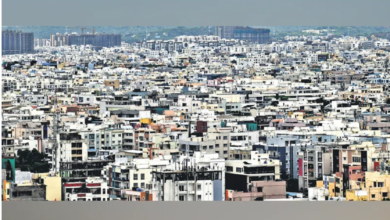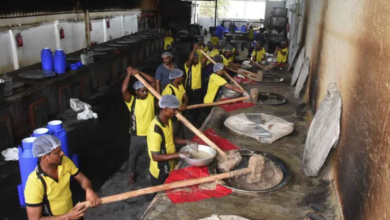‘Sunkishala’ to end Hyderabad water woes

Hyderabad: After ensuring that there is no drinking water shortage, or long queues for drinking water anywhere in Hyderabad, the State government is now planning for the future with the Sunkishala Intake Project, the foundation of which has been laid on Saturday.
The Sunkishala Project, which aims to address the drinking water needs of people living in the Greater Hyderabad Municipal Corporation limits and Hyderabad urban agglomeration area, is likely to be completed by next summer with the project being built keeping in mind the water needs for the next 50 years, Municipal Administration & Urban Development Minister KT Rama Rao said after laying the foundation stone.
The present water requirement of Hyderabad ie., in 2022, was 37 TMC which would go up to 70.97 TMC by 2072, the Minister said, adding that by 2035 the water requirement of Hyderabad would be 47.76 TMC, which by 2050 it would be 58.98 TMC. This, by 2065 would further scale up to 67.71 TMC. The project, which will ensure adequate drinking water even if there is no proper monsoon for five years, would also address the water requirement for industrial consumption in Hyderabad and its vicinities, he said.
To date, water is being supplied to the city and its surroundings by drawing from Krishna, Godavari, Manjira and Singur sources. The Sunkishala project was in order to have permanent and independent arrangements for the existing Krishna Drinking Water Supply Project schemes of Phase-I, II & III. “For the Krishna Drinking Water Supply Project schemes Phase-IV & V, civil works are currently being executed,” Rao said.
Presently, water is being drawn from the Alimineti Madhava Reddy Project irrigation canal, which uses water from Krishna via the Nagarjunasagar Project. When the water levels in Nagarjunasagar reservoir get depleted below the Minimum Draw Down Level (MDDL) of 510 feet during the summer season, the existing canal system is not able to deliver water to Krishna Drinking Water Supply schemes. The Hyderabad Metropolitan Water Supply and Sewerage Board then installs emergency pumping systems at the foreshore of Nagarjunasagar to draw water below the MDDL.
The Sunkishala project will end this major issue of emergency pumping during summers, with Sunkishala being identified as the point where water can be drawn below MDDL up to 462 feet.
Intake well to save Rs 6 cr for HMWSSB per year
Intake well and pumping station at Sunkisala would save Rs 5 crore to 6 crores for Hyderabad Metropolitan Water Supply and Sewerage Board (HMWSSB), which would be spent for setting up of motor pump sets to draw Krishna water when the dead storage level in Nagarjuna Sagar Project for the purpose of drinking water supply to Hyderabad during summer.
Speaking at a programme held at Sunkisala, HMWSSB Managing Director M Dana Kishore said that they have no other option but to use three or four emergency motors to pump water from Nagarjuna Sagar Project when the water storage level was below 512 feet for the purpose of drinking water supply to Hyderabad.
Once Sunkisala intake well and pumping station were completed, there would be no need for using emergency pump sets to draw water, he added. He said that out of 650 meters running tunnel with eight-diameter pipe, works of 320 meters tunnel was completed. At the intake well, 12 pump sets would be kept running and six pump sets would be kept stand-by. The intake well would spread in 125 acres.
The present water requirement of Hyderabad ie., in 2022, was 37 TMC which would go up to 70.97 TMC by 2072, the Minister said, adding that by 2035 the water requirement of Hyderabad would be 47.76 TMC, which by 2050 it would be 58.98 TMC. This, by 2065 would further scale up to 67.71 TMC. The project, which will ensure adequate drinking water even if there is no proper monsoon for five years, would also address the water requirement for industrial consumption in Hyderabad and its vicinities, he said.
To date, water is being supplied to the city and its surroundings by drawing from Krishna, Godavari, Manjira and Singur sources. The Sunkishala project was in order to have permanent and independent arrangements for the existing Krishna Drinking Water Supply Project schemes of Phase-I, II & III. “For the Krishna Drinking Water Supply Project schemes Phase-IV & V, civil works are currently being executed,” Rao said.
Presently, water is being drawn from the Alimineti Madhava Reddy Project irrigation canal, which uses water from Krishna via the Nagarjunasagar Project. When the water levels in Nagarjunasagar reservoir get depleted below the Minimum Draw Down Level (MDDL) of 510 feet during the summer season, the existing canal system is not able to deliver water to Krishna Drinking Water Supply schemes. The Hyderabad Metropolitan Water Supply and Sewerage Board then installs emergency pumping systems at the foreshore of Nagarjunasagar to draw water below the MDDL.
The Sunkishala project will end this major issue of emergency pumping during summers, with Sunkishala being identified as the point where water can be drawn below MDDL up to 462 feet.
Intake well to save Rs 6 cr for HMWSSB per year
Intake well and pumping station at Sunkisala would save Rs 5 crore to 6 crores for Hyderabad Metropolitan Water Supply and Sewerage Board (HMWSSB), which would be spent for setting up of motor pump sets to draw Krishna water when the dead storage level in Nagarjuna Sagar Project for the purpose of drinking water supply to Hyderabad during summer.
Speaking at a programme held at Sunkisala, HMWSSB Managing Director M Dana Kishore said that they have no other option but to use three or four emergency motors to pump water from Nagarjuna Sagar Project when the water storage level was below 512 feet for the purpose of drinking water supply to Hyderabad.
Once Sunkisala intake well and pumping station were completed, there would be no need for using emergency pump sets to draw water, he added. He said that out of 650 meters running tunnel with eight-diameter pipe, works of 320 meters tunnel was completed. At the intake well, 12 pump sets would be kept running and six pump sets would be kept stand-by. The intake well would spread in 125 acres.







